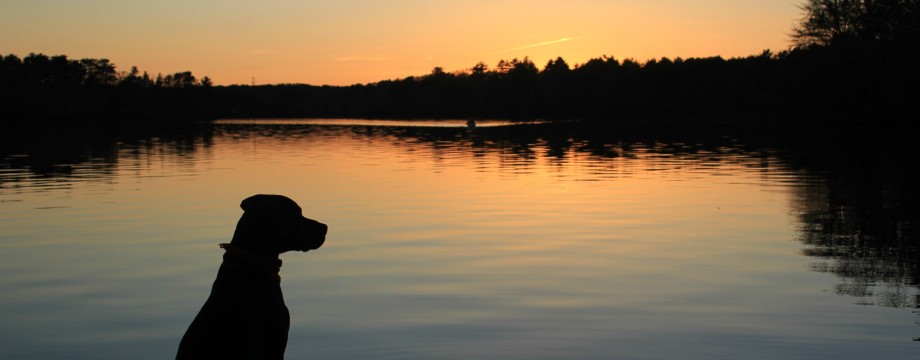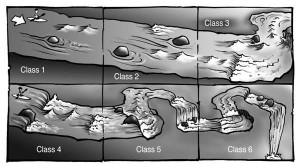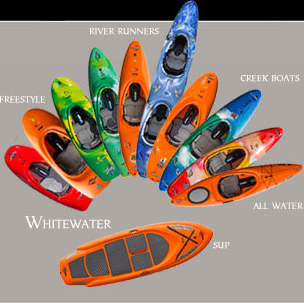
So many options!
Anyone interested in getting into whitewater kayaking faces a daunting challenge-which boat is right for you? With all of the different makes, models, shapes and colors, it’s tough to know where to start.
There are three questions that I ask anyone who comes into my shop interested in purchasing a whitewater boat:
1) Where will you paddle most often?
2) What do you see yourself doing?
3) What’s your weight?
Let’s break down these questions to understand why they’re important and how they can help you select a whitewater boat that’s right for you!
Where will you paddle most often?
There are a few key factors that influence the character of whitewater rivers and their features. It is important to remember that each river has its own unique character.
Gradient- The gradient of a river, measured in Feet-Per-Mile, reflects the steepness of a run. Generally, the greater the gradient, the more difficult the run.
Water Level- Whitewater rivers, their features, and difficulty, change greatly with the amount of water in the river. Sometimes this is the difference between a Class II and Class IV, while other times the river might be too low to paddle.
Geology- Rocks in the river bed create almost all of the features on a whitewater river. Their composition, historic rate of erosion and shape create the waves, holes and eddies that paddlers use to navigate the river.
A useful resource for checking water levels, river difficulties and logistics information is American Whitewater. American Whitewater is the premier whitewater advocacy organization that works to ensure access and recreational releases for our favorite rivers, in addition to providing flow information to the paddling community.
Knowing your local whitewater resources is the first step toward choosing the right boat. If you live near a play spot, such as Tariffville Gorge in Granby, CT, you’ll likely want a play boat. If you live near a longer section of river with limited play potential, a river runner might be more appropriate. Talk to your whitewater friends, or join a club such as the AMC. These paddlers will be more than happy to point you in the right direction.
What do you see yourself doing?
Whitewater kayaking designs are currently driven by extremes. Nearly all of the whitewater films you’ll find feature someone dropping an extreme waterfall, or surfing the world’s largest river waves. If one of these activities grabs your attention, great, you can select a boat that leads you to your goal.

Dagger Jitsu in Action
Playboating/Freestyle- Playboating, aka Freestyle, involves surfing standing river waves or holes and doing tricks such as spinning, cartwheels, looping, etc. These require a fairly specific set of whitewater features-that are fairly common in New England. The best play boating features on the East Coast are found on Quebec’s Ottawa & St. Lawrence rivers.
River Running-River running gets you where you’re going. This catch-all category involves going from put-in to take-out and making use of all the features in between. This is the category that most paddlers would fall into, regardless of the type of whitewater boat they use.
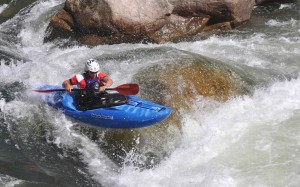
The Stomper in its element. Photo by Matej Holub
Creeking- Creeking refers to kayaking small, steep and often extremely technical (and dangerous) runs. These rivers often feature big drops with must-make moves. These rivers are often rarely run and can include hazards such as downed trees. Special care and training is required to creek safely.
What’s your weight?
All whitewater kayaks come in multiple sizes based on the paddler’s weight-consult the manufacturer’s website for weight recommendations. With some minor exceptions, it’s best to be in the middle of the recommended weight range.
Now that we have an idea about your local paddling resources and goals, we can discuss the physical differences in boat design. It’s important to remember that whitewater boats exist on a spectrum-just like sea kayaking, you can never have too many boats!
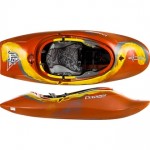
Dagger Jitsu
Play boats, such as the Dagger Jitsu, are typically lower volume, and feature flat (known as planing) hulls as well as aggressive rails that help the boat carve on the surface of a wave. Additionally they feature nearly vertical side walls and tend to be short. They feature less initial stability, but are very stable if paddled aggressively. For this reason there is a bit of a learning curve for a paddler starting off in a play boat.
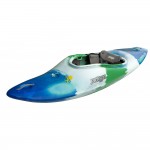
Jackson Fun Runner
River runners, such as the Jackson Fun Runner, tend to be longer and faster than play boats, but have less volume than creekers. They tend to limit the possibilities for aerial moves, however they are typically more comfortable and provide greater confidence in bigger water or on colder days (when you want to stay upright as much as possible!)
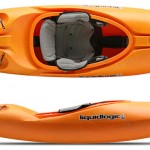
Liquid Logic Stomper
Creekers, such as the Liquid Logic Stomper, are the big boys of the sport-they feature the highest volume and are made for the biggest features. They tend to be big and heavy, but with rounded (displacement) hulls, feature little to no edge to ‘trip’ over and therefore are very forgiving for beginning paddlers.
Again, it’s important to remember that there is no one right answer. All of the boats currently on the market have capabilities that are only limited by the paddler’s ability. An investment in gaining river time and experience in a beater boat is far more valuable than searching for “The One”. So take advantage of opportunities to paddle as many designs as you can from different categories, take a class, push the limits of your confidence and ability in a safe environment. Don’t fall into the trap of tying your confidence to one design. You’ll be happy you did!
See you on the water!
Keith Reinemann
Zoar Outdoor


